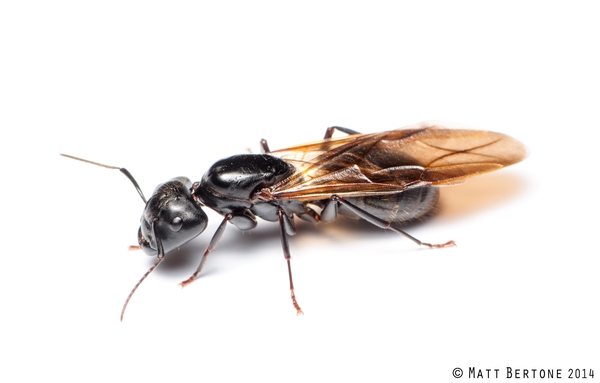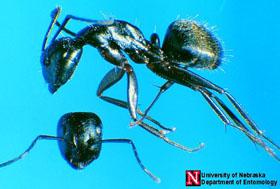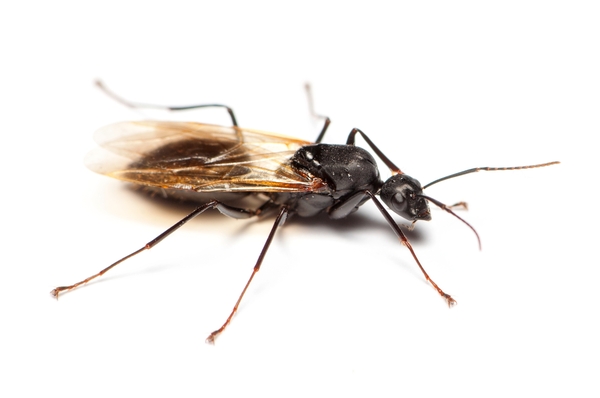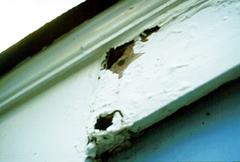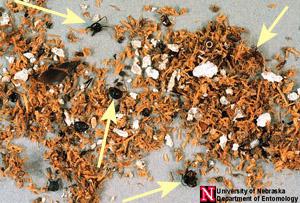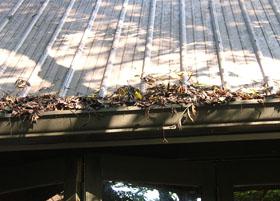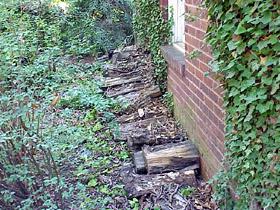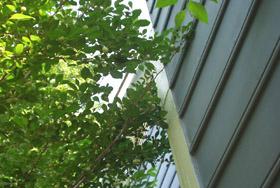Introduction
Carpenter ants are generally considered of lesser importance compared to termites in terms of the amount of structural damage they can cause. However, a carpenter ant problem that is ignored or goes unnoticed can lead to significant damage to wood. The term "carpenter ant" is applied broadly to several species of ants that nest in or around wood. However, our primary concern is with ants in the genus, Camponotus. This genus contains pest species of carpenter ants. Some of these species actually tunnel into the wood, while others prefer to nest in existing cavities. In this article, we discuss how to identify, prevent, and manage new and existing carpenter ant problems.
Biology of Carpenter Ants
Carpenter ants are among the largest ant species that you will find in North Carolina. The queen usually reaches 9⁄16 of an inch in length. The workers are what we call polymorphic, and range in size from ¼ to ⅝ of an inch. So, if you see different sized ants, they could all be carpenter ants from the same colony. The terms for workers, depending on their size, are: major (largest), media (mid-range), and minor (smallest). Once an ant reaches the adult life stage, regardless of their size, it will not grow anymore; i.e., minor workers will never reach major worker size. Additionally, adult carpenter ants will vary in color depending upon the species. The black carpenter ant (Camponotus pennsylvanicus), the species that most commonly nests in homes, is primarily black in color (thus the name). Other carpenter ant species may be reddish-brown to yellow.
Carpenter ants undergo complete development (egg, larva, pupa, adult). The pupae are enclosed in cocoons that are often mistaken for eggs. The immature ants (larvae) are white, legless, and look a lot like maggots. Larvae are helpless and are fed food from foraging workers. Workers are able to bring food back to the colony because they can store it in their crops (a specialized pouch near the stomach used for holding food). Although, interestingly, adult ants cannot digest solids, so larvae are responsible for liquifying all solid foods (typically using their ‘belly’). Then, adults ingest the liquified product. Adults then share this food with one another, larvae, and most critically (when we consider control) with the queen. So, larvae may be fairly helpless, but they certainly are not useless! The larvae develop into pupae, which are tan and capsule-shaped. Eventually, new adults emerge from these pupae.
Within a colony, only the queen produces eggs. The black carpenter ant queen (Figure 1) lays eggs once in early spring and again in late summer. This approach to egg production allows for two adult cohorts per year. Eggs laid in the spring generate workers (Figure 2) and sexual forms (Figure 3) that mature in August and September, whereas eggs that are laid in the summer produce workers the following summer. It takes months for eggs to develop into adults; thus, the carpenter ant colony is fairly slow-growing. A new colony requires many years (up to six) to fully mature. Mature colonies contain 2-3,000 workers that can live many years, and produce 200 to 400 winged forms or "swarmers" every year. Swarmers are reproductive adults that mate outside of the nest. They are produced in the fall, but wait until spring to take flight. Males die shortly after mating while mated females shed their wings and find a new nest site to begin the process all over again. Each queen lives as long as 15 years. Until she dies–the colony will continue to produce new workers, swarmers, and satellite nests (described below).
Biology of the Colony
Shortly after mating, the female (new queen) loses her wings and searches for a cavity in wood or soil where she begins to lay eggs and produce her colony's first workers. These are the only workers in the colony that the queen will ever raise and care for directly. However, we said she hides herself in a cavity, so where does she get food for these first larvae? Remember that she takes flight from her parent colony to mate, and then loses her wings. Now, she has no need for those powerful flight muscles, so she dissolves them to feed her growing larvae, ensuring she can raise them while remaining tucked away. These workers, smaller than minor workers and called “nanitics” tend to the queen as she produces more offspring. They assume the tasks of foraging for food, maintaining and expanding the nest, and caring for newly-produced young. If anything happens to these first crucial workers the queen and nest will die. Unlike some other ant species, carpenter ants are capable of maintaining satellite nests in addition to this primary colony. “Nests” and “colonies” are two different concepts. Satellite nests are formed by workers that move out of the primary nest and take some of the existing larvae and pupae with them. Eventually, satellite nests can produce their own reproductives. However, the colony is still uniform, in that it contains only one queen and she resides in the primary nest. Having multiple nests helps the colony hedge their bets, so to speak. In case of an attack on one nest, others are already established for quick movement of brood and workers. It gives the queen spaces to move to as well in case of damage to the primary nest.
Regardless of their nest location, carpenter ant adults are omnivorous. They love honeydew, the sugary secretions of certain plant-feeding insects like aphids. For that reason, you can often find worker carpenter ants traveling up tree trunks and onto limbs in search of honeydew on the plant’s leaves. In some cases carpenter ants may “tend” and protect groups of aphids to ensure continued access to their sugary secretions, earning aphids the endearing nickname “ant-cows”. Additionally,the ants will feed on plant secretions and fruit juices, as well as on the remains of insects, including dead members of their own colony. When carpenter ants invade homes, they usually seek out sugar-containing sweets, but they also will feed on fats, grease and meats. Water is also crucial to their survival. Outdoors, you will often find ants collecting water dripping from water spigots, downspouts or air conditioner drain lines. Indoors, the ants are often seen near sinks, bathtubs and dishwashers.
Where do they Build Nests?
Unlike termites, carpenter ants do not eat and consume wood. Instead, they tunnel through wood (using their mandibles/jaws) while building or expanding their nests. Typical outdoor nesting sites include tree holes, tree stumps, logs, standing dead trees, and planter boxes. When conditions are right, carpenter ants may establish nests indoors. Typical indoor nesting sites include structural wood, wall voids, attic areas, insulation, hollow doors, window/door casings, voids beneath kitchen/bathroom cabinets, as well as hollow beams (e.g., decorative beams that may cover pipes or girders). In the case of carpenter ant species that nest in existing cavities, the workers may subsequently invade and damage nearby structural wood while expanding their nest site. Carpenter ants prefer wood with a moisture content of 15% or higher, so a carpenter ant problem is often associated with a moisture problem (Figure 4, Figure 5). The ants often invade homes through cracks and crevices in the foundation masonry, around windows and doors, as well as heating/AC vents (Figure 6). They may travel along tree limbs or shrubs that touch the siding and roof, gaining access to attic areas. Telephone, electric and cable TV lines also provide ants an easy path inside the home.
Indicators of a Carpenter Ant Infestation
There are several indications of a carpenter ant infestation:
Swarmers: The appearance of swarmers indoors is, unfortunately, an indication of a nest in or under the house. Winged, reproductive ants will emerge from around baseboards, window casings, vents or other openings in floors or walls. They will often congregate around windows. However, swarmers found outdoors on porches, siding or on windows are probably just a sign of a nearby colony located outdoors. However, if you see swarmers at all, it is well worth the effort to inspect your home for other signs of ant activity to be absolutely sure that you are in the clear.
Workers: Beginning in early spring, worker ants will often be found foraging for water around bathroom/kitchen sinks, dishwashers and/or showers. Foraging activity is usually greater at night when the lights are off or the sun has set, but you might also find ants during the daytime, too. In some cases, you may be able to trace the insects back outdoors where they are traveling to and from a nearby nest. When extensive foraging has occurred, you can even find trails that are clear of debris and carefully maintained by traveling ants. These trails may extend up to 300 feet away from the nest.
Chewing Noises: With mature colonies infesting a house, you can actually hear rustling or gnawing sounds coming from the wood or void where they are nesting. Ants will also make rustling sounds when they are alarmed.
Sawdust: As the ants expand their nest, they throw out piles of fiber-like wood debris and frass (fecal material) that is similar in appearance to pencil shavings. Debris with a dark appearance is an indication of decaying wood and can be used as a clue in searching for the nest. The frass will also contain the remnants of ants and other insects on which the colony has been feeding. This frass is distinct from that of other wood damaging/destroying insects, and is frequently found by pulling back insulation around suspected areas in the crawlspace.
Damage: Wood that is damaged by carpenter ants may have slit-like openings through which the ants expel sawdust and frass. The galleries will usually run parallel to the wood grain with the softer "springwood" portion of the annual rings being excavated first. Tunnels through the harder summerwood connect the galleries. The gallery walls will be smooth, resembling drywood termite damage. However, the galleries of drywood termites are usually filled with small, hard, seed-like six-sided fecal pellets that do not resemble the wood fiber debris that carpenter ants remove from their galleries. Wood damaged by subterranean termites also has excavated areas, but the gallery walls are filled with a mud-like fecal material. Conversely, carpenter ants keep their galleries quite tidy. The sides of carpenter ant galleries look almost sandpapered in appearance.
Preventing Carpenter Ant Problems
Anytime there are trees, stumps or other wood items around our home, there is always the potential for a carpenter ant problem (Figures 8, 9, 10, 11). However, there are important steps that you can take now to prevent carpenter ants from establishing. Prevention starts with common sense and inspection, not with a monthly or periodic pesticide application. Proper maintenance of your home and surroundings greatly reduces the likelihood of a carpenter ant problem. The key point to remember is that carpenter ants are usually associated with moisture:
-
Check for moist, soft or rotting structural wood. Pay particular attention to:
-
attics, roof edges, eaves and gutters
-
flashing around chimneys, porch or deck roofs
-
porch roofs, railing and columns
-
door and window frames
-
areas with water damage (new or old) in the crawlspace
-
-
Flat roofs can be particularly vulnerable to moisture problems if they are not maintained properly.
-
Keep gutters and downspouts clear of debris so that rainwater does not dam up and overflow, possibly damaging fascia boards.
-
Repair dripping outdoor water spigots or other plumbing leaks that might attract foraging ants.
-
Maintain proper drainage around the exterior of your home.
-
Whenever wood must be in direct contact with soil or masonry (e.g., when installing landscape timbers, porch columns, decking, fencing, etc.), use the correct type of pressure-treated lumber.
-
Repair cracks in your foundation that provide easy access for the ants (and termites, as well).
-
Keep your crawlspace dry and well-ventilated. A properly installed vapor barrier will help.
-
Never stack firewood on your porch and deck, or against the side of your home, or in a garage. Keep firewood stacked up off the ground for easier inspection.
-
Keep tree limbs and shrubs pruned back away from your house.
-
Remove nearby trees that are dead or in poor health. Get advice from a tree specialist about the health of the trees surrounding your home.
Controlling Carpenter Ants
It is important to remember that finding carpenter ants foraging inside your home does not necessarily mean that they are nesting indoors. Do not panic if you see them, and do not resort to spraying insecticides indoors where you see ants. Although spraying stops ant foraging for a while, it only serves to repel and send them elsewhere (possibly elsewhere indoors) and they will likely return when the chemical residue is gone. More importantly, you may be delaying the inevitable discovery that the ants are actually damaging your home. The first step in controlling carpenter ants is to determine if they are nesting indoors. Spraying your foundation with any of the commonly available insecticides labeled for carpenter ants may keep foraging ants away temporarily, giving you a clue as to the source of the ants. If ant activity continues at about the same level after spraying, then you might have an indoor infestation.
As an alternative to spraying, you can try baiting the ants outdoors. Put small amounts of honey mixed in water into bottle caps (or similar small containers) and place them along the foundation. Carpenter ants are nocturnal, so do this investigation after sunset. Try to follow the ants as they move away from the baits and back to their nest. In most situations the ant nest is located nearby, although it could be as many as 300 feet away from where you find foraging ants. The main purpose of baiting is simply to see where the ant trail leads. If the ant trails move away from the house, you can use one of the control methods mentioned below for outdoor infestations. Instead, if the ants appear to be nesting indoors, the next step is to carefully inspect your structure. Concentrate first on those areas around your home that are most vulnerable to moisture problems. Probing the wood with a screwdriver is a good way to uncover damage by a number of wood-destroying pests, including carpenter ants and termites. Careful inspection of the attic and crawlspace are important. Because of the time-consuming and tedious nature of a thorough inspection, you may want to enlist the help of a pest control company that has the experience and the ability to quickly find and eliminate the ants.
Indoors: Simply spraying surfaces where you see ants foraging is not likely to solve the problem. The ants are likely to move to some other area (still indoors) and may return later when the chemical residue is diminished. Ant baits, particularly those containing hydramethylnon, avermectin or boric acid, can be effective if the ants are foraging for food. If the ants are gathering around water sources (e.g., a sink), they may not immediately be attracted to the bait. However, in general, baits are the best approach to dealing with ants. They are more effective in the long term and are less hazardous (compared to sprays) when used properly. Specifically, make sure baits are placed in locations inaccessible to pets and young children, such as voids behind outlet covers, inner areas of window-sills, or in areas around the crawlspace. Don’t worry if baits aren’t directly in the path of the ants you’ve seen, they are great at finding food so they will find the bait. However, they may require 7-10 days before ant activity declines significantly. You must be willing to tolerate some ant activity to give the foragers enough time to carry the bait back to the nest where it will be fed to the larvae, other workers, and to the queen.
Importantly, do not spray pesticides in areas where you will place the bait; otherwise, the ants will avoid and not pick up the bait. If ant activity continues at about the same level for several weeks, then you need to take additional steps to deal with the problem. Before spraying, you should first determine the extent of any structural damage caused by the ants. This may require removing siding or portions of sheetrock (indoors). If the damage is severe, repairing and/or replacing wood (and subsequently removing the nest) may be more important than any treatment and may solve the problem in the process. If damage is minor, then use a pesticide that is labeled for application to wood to eliminate the nest. Effective control often requires the injection of insecticidal dusts or sprays into voids or into the nest. These treatments are complex and may be too difficult for the average person to carry out safely. Contact a pest control professional for help in these situations.
Outdoors: If the ants are foraging from an outdoor nest that cannot be found, then a perimeter treatment can help. Liquid or granular insecticides applied to/along the foundation will cut foraging activity temporarily, but they will not prevent ants from returning at some later date. A list of these products can be found in the North Carolina Agricultural Chemicals Manual. A better choice might be a granular ant bait sprinkled in a 8-12" area on the soil along the foundation. Note: Granular baits are not the same as granular contact insecticides that are often used for controlling lawn pests. Granular insecticides may be helpful, but must be watered into the soil, and they require contact by the ants for efficacy. Baits require consumption by the ants. It is better to put bait near foraging trails, versus randomly placing it throughout the environment. Finally, regardless of the chosen method, be prepared for complete eradication to take one to two weeks, especially if the colony is large.
Read product labels carefully to be sure that you buy the right product and apply according to label instructions.
Acknowledgements
We thank Mike Waldvogel and Patty Alder for developing the previous version of this factsheet.
Publication date: Aug. 7, 2008
Reviewed/Revised: Feb. 7, 2023
Recommendations for the use of agricultural chemicals are included in this publication as a convenience to the reader. The use of brand names and any mention or listing of commercial products or services in this publication does not imply endorsement by NC State University or N.C. A&T State University nor discrimination against similar products or services not mentioned. Individuals who use agricultural chemicals are responsible for ensuring that the intended use complies with current regulations and conforms to the product label. Be sure to obtain current information about usage regulations and examine a current product label before applying any chemical. For assistance, contact your local N.C. Cooperative Extension county center.
N.C. Cooperative Extension prohibits discrimination and harassment regardless of age, color, disability, family and marital status, gender identity, national origin, political beliefs, race, religion, sex (including pregnancy), sexual orientation and veteran status.

